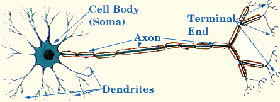Diffuse Brain Injury
Diffuse brain injury can exist in four principal forms, although only three of these forms involve patients who have any chance of survival.
- Diffuse axonal brain injury;
- Diffuse hypoxic/anoxic/ischemic injury;
- Diffuse swelling and
- Diffuse vascular injury.
Of these four, diffuse axonal injury is the one that is gaining the most attention. Part of the reason for the focus on the axonal injury is undoubtedly its relationship in its less severe forms, to the sequelae of subtle brain injury. The consequences of diffuse hypoxic/anoxic/ischemic brain injury are often catastrophic, although the degree to which non-severe occurrences of these phenomenon result in subtle sequelae is an area on which future research may shed light. Likewise, the effects of diffuse brain swelling can span the spectrum of severity, with little being understood about the interplay of subtle changes upon long term symptomatology.
The problem in understanding the nature of the pathology of diffuse brain injury, is that as these injuries typically occur on the cellular level, which makes them far too small to be seen except under a microscope. A microscope can only be used to examine cells of the brain after death, meaning that scientists rarely get to examine brain cells of those with documented concussion.
Advances in functional imaging have increased the speed at which neuropathologists can learn about the subtlely injured living brain and it is hoped that in the next several years, much will be learned about these pathologies and how to prevent their potentially disabling effects. Progress in MRI is occurring rapidly, and some MRI centers are now able to find evidence on MRI of diffuse axonal injury. (This evidence is of correlative petechial hemorages, which are indicative of a shearing injury.) As the software to interpret the digital data generated by the newer, more powerful MRI magnets improves, a substantial percentage of concussions which were difficult to “objectively” prove, may result in clear cut MRI abnormalities.
 To understand why concussion can have permanent deficits, it is important to understand diffuse axonal injury. The first step in understanding axonal injury, is understanding the microbiology of the brain and its core cell, the neuron.
To understand why concussion can have permanent deficits, it is important to understand diffuse axonal injury. The first step in understanding axonal injury, is understanding the microbiology of the brain and its core cell, the neuron.
Source: w, ©1997, Arnold, page 209.
The Structure of a Neuron